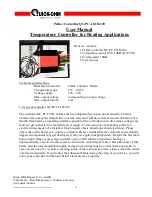
F-26277-7
©
Copyright 2006 TAC All Rights Reserved.
9
Wiring
The following electrical connections can be made to the TAC I/A Series MicroNet Sensors:
•
Sensor Link (S-Link) Wiring
•
TAC MicroNet L
ON
W
ORKS
network (LON) Wiring
Caution:
Do not connect any power wiring to the TAC I/A Series MicroNet Sensor.
Failure to observe this precaution will damage the sensor.
Communications Wiring
Communications wiring includes a connection between the controller and an TAC I/A Series
MicroNet Sensor via the S-Link and an optional connection between the sensor and the TAC
MicroNet L
ON
W
ORKS
network (LON). Figure-7 shows S-Link and LON wiring terminations.
Sensor Link (S-Link) Wiring
S-Link wiring powers and enables the MN-Sxxx sensor. The S-Link needs at least 24 gage
(0.205 mm
2
), twisted pair, voice grade telephone wire. The capacitance between conductors
cannot be more than 32 pF per foot (0.3 m). If shielded cable is used, the capacitance
between any one conductor and the others, connected to the shield, cannot be more than
60 pF per foot (0.3m). Maximum wire length is 200 ft. (61 m).
Note:
•
S-Link wiring is polarity insensitive.
•
Shielded cable is not required for S-Link wiring.
•
If conduit is used between an TAC I/A Series Sensor and a controller, the TAC MicroNet
L
ON
W
ORKS
network and S-Link wiring can be in the same conduit.
•
S-Link wiring can be in the same conduit with UI, AO, and DI Wiring.
•
S-Link wiring must be dedicated to S-Link communications. It cannot be part of an
active, bundled telephone trunk.
•
If the cable is installed in areas of high RIF/EMI, the cable must be in conduit.
Connect the S-Link to TAC I/A Series MicroNet Sensor
1. Strip 1/4 in. (6mm) of insulation from S-Link wires.
2. Connect wires to screw terminals 1 and 2 (Figure-7). The S-Link terminals are polarity
insensitive.
3. Push excess wire back through the base plate to minimize air flow restriction.
Figure-7 S-Link and LON Connections.
LON leads
S-Link
leads






































